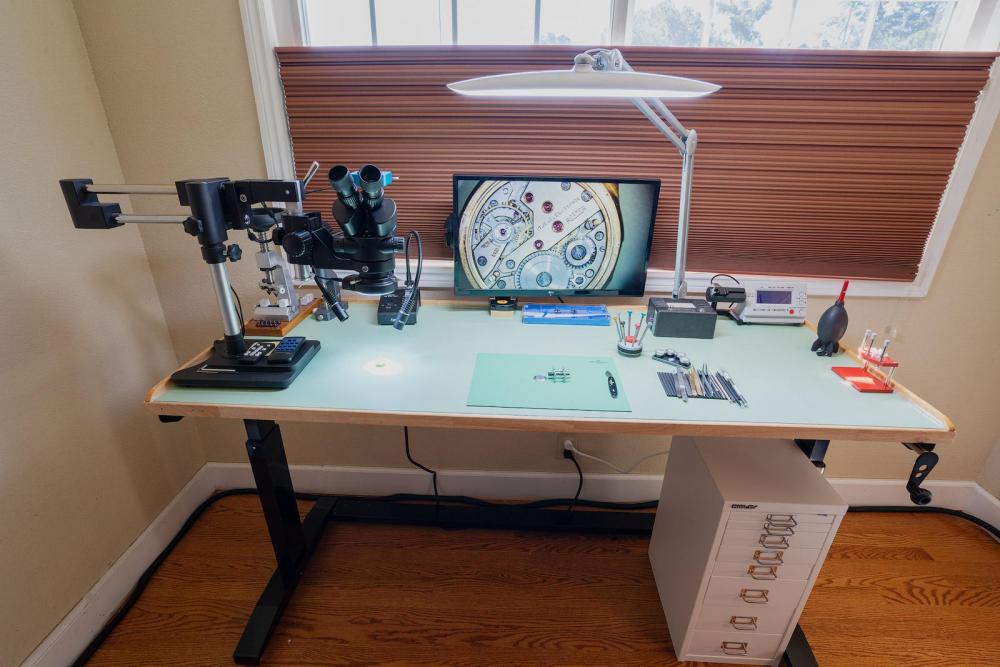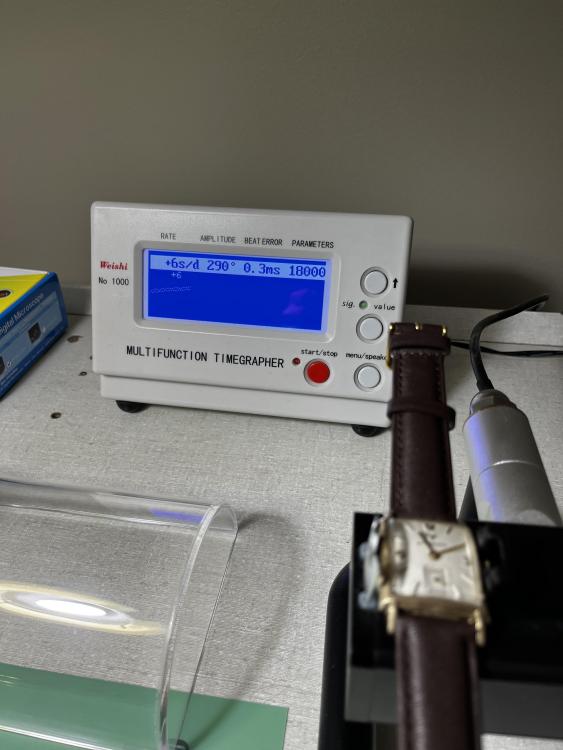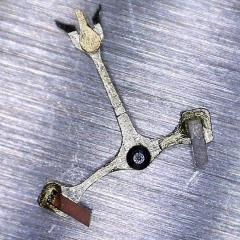Leaderboard
Popular Content
Showing content with the highest reputation on 05/29/22 in all areas
-
I was inspired by a post on the Watch Repair Lessons Facebook group showing a DIY watch bench. It's using a 62" Husky adjustable height desk with some added rails along the back and sides and a Vyco table mat on the desktop. My old setup was so cramped and jumbled together and now after getting rid of my old office desk, I have a lot more room to work and I can adjust the height of the desk to ideal. I'll eventually be adding some more drawers/tables along the sides for storage. It was (somewhat) cost effective with the desk costing $199 (on sale), the Vyco mat $75 (free shipping), and the rails just some pine from my local lumber yard for $14.3 points
-
If you were able to record the sound that well you might also be able to use a cheap timegrapher app to evaluate beat error and amplitude. The beat error sounds to be huge! Edit: I just let my timegrapher app analyse your audio file. It says +540s/d and 12ms beat error! May be wrong but …3 points
-
I think that just the fact that a flat pusher "pushing" on a flat surface has "mechanical merit" vs. using a concave pusher on a flat surface. More even contact across the face of the jewel...less chance of damage Just my thoughts. Randy3 points
-
Mystery solved. Turns out that the caseback inside wall was tapered at the edge by design and was coming in contact with the hairspring stud screw head. I forgot to mention that I did install a balance complete. The new hspg stud must not have allowed the stud screw to thread in as far as the prior stud did. Also, I noticed when I uncased the movement and placed it back on the timer, I would see a gradual increase in timing indicating that things were running very slow when cased (binding taking place). I don't know how that would result in the watch gaining time though? I ended up giving the case back a few small hammer taps to a round nose staking tool which provided enough tolerance for the hairspring stud screw head to not touch. Thanks for the look.2 points
-
Have you checked if the movement out of the case gain a couple of minutes an hour too ? I wonder if it's incorrect timegrapher readings causing confusion - the top pic shows 2.4 ms beat error, the bottom 0.4 ms. Why? Maybe just a weak sound when cased. It's best to put the crown against the metal bit of the timegrapher, especially when cased, as it gives a stronger signal (The crown connected to the mainplate transmits the sound better than through the case).2 points
-
There you are , huge beat error, so move the beat adjustor arm to reduce the beat error, it may sound alright then, If no joy, its got more issue with hairspring or roller/ impulse. Kalanag, I am proud to extend special welcome to experienced/ knowlegable and helpful members like yourself. Regds2 points
-
If you can see the oiling in the balance jewels and it looks good, and the watch is running fine and winding correctly with the automatic, just keep wearing it until the oil looks like it has depleted somewhat, amplitude starts to drop, or the rotor starts spinning when you handwind (sign the reversers need servicing). If a watch has been properly cleaned and serviced to ETA factory spec it really should run 10 years without issue.2 points
-
Because the debris sticks to a certain tooth of a certain wheel and prevents the restart only when this tooth meshes with its counterpart.2 points
-
Ohoh. I think you've just jinxed yourself. There is an unwritten rule in watchmaking which is never to congratulate yourself for not dropping things.2 points
-
Hmm not sure . Sounds like its beating a little irregular. Generally if the watch is running fast it would be due to a dirty hs or a hs that has become magnetised making the coil stick together slightly when contracting and releasing. Try cleaning and a demagnetise first. Then watch the hs breathe in and out when its oscillating preferably under a scope if you have one , you should notice an issue visually. Check it for flat and trueness inside the watch while its running. It is possible the hs is too short, i have a couple of old ones that broke on me that i had to repin. They run approx five mins a day too fast with full slow regulation. So you may need to hunt for another hs if this is the case. Its possible to make adjustment to the balance wheel if there are adjustment screws, but i would suggest trying everything else and have this as a final resort. Ask for more advice here before you attempt this.2 points
-
Sounds galloping, Clean the hairspring and demag. What happens when you move the beat adjustor arm? Intermitenet sticking is easy to miss by visual inspection, you might need to take a slo mo vid of the coil to see intermittent sticking. Good luck2 points
-
1 point
-
1 point
-
As a decaying nucleus fissions it transforms into smaller nuclei so alpha particles among many others may pop into existance what actually happens, is that the released energy may be enough for making a new particle and the energy flow tends to stablize at the first possible stable state. Alpha particle is nucleus of helium, upon forming it quickly absorbs two electrons to stablize as helium, the newly formed helium is still as radio active as its nucleus, so if inhaled or ingested two major route it may go. 1- It may just go through our digestive system and leave our body, though it may get re-absorbed in vegtables or other food we eat , It wont disappear it just dispersses in nature. 2- It may get absorbed in some organ of our body. It all depends on the chemical composition of what we have ingested/ inhaled. Let presume its absorbed in our blood, it will stay and circulate throughout our body where ever blood goes. providing sufficient amount of radium in our blood it may cause blood cancer. If however the radio active nuclei ends up in our nail or hair it will depart in a few months, so exposure periods differ. Alpha particles do penetrate solid material like our bones or flesh, but only a short distance, it travels only a few centermeter in air. Its a massive particle so wont travel far. Other fission products such as beta or gamma particles are considered massless , they are of elctromagnetic nature so they frantically travel through the space for they have no mass or mass too small that we have been unable to discern/detect, as we speak we are recieving particles released at big bang. Consider the vastness of routes fission product may head and you will see we are the ingrediants of a soup material existance is made of, about all we can do is to stay away from strong current of radioactivity and minimize our exposure to it. Guys who made and sell you this toy "the gieger counter " knew that our brain produces fear when dealing with unknown. For all we know you could be living near a strong radioacrive source all your life, did anyone measure the dose in imported sugare or fronts coming you direction form near or far neighbores. If you work on watches just don't inhale/ ingest the luminous material and stop worrying about a threat thats no threat to you. I spent years experimenting with nuclear reactors and I know for a fact my accumulative exposure is neglegible. STOP WORRY ING.1 point
-
Synthetic oil has been around for well over 50 years, so I don't have much of an opinion on it versus mineral oil, as I doubt any professional has used mineral for almost that period. But synthetic will tend to evaporate rather than gum up; there, the danger of not servicing is the watch then runs without lubrication causing damage, where mineral oil would cause the watch to stop or run so poorly you would know it needs service. No thoughts as to quartz watches- I might work on one or two a year for friends but otherwise know nothing about them (aside what I learned in school 25 years ago)!1 point
-
Would these be the same indications of a needed service regardless of a synthetic or a mineral based oil. I'm assuming you that you wont use a mineral based oil now but may have earlier in your career. Obviously correct servicing times are always the best answer, but any thoughts as to synthetic vs mineral are very interesting. What are your thoughts on the Yema quartz Vw. I really like the look of it and its an ok diver with 200 metres. But that Ronda 515 ?1 point
-
Always nice if you give us a picture of the watch. Just in case we all didn't instantly recognize this as a ladies wristwatch? Or is it a pocket watch? In addition the fixing they hairspring anything else you did to the watch? Are there any other observations like when was the last cleaned?1 point
-
Except on a weekend . Excuse my rather basic and low tone humour today. Its my day off and i did work a full week this week.1 point
-
1 point
-
I played it to my timegrapher, for the few seconds i got it to analyse it was all over the place as well. Post up some pictures of the balance running, we may apot something obvious happening1 point
-
Hello and welcome. I've have lost countless screws but with practice and good tweezers I rarely drop them any more.1 point
-
It could just be that it's not in beat. The more out of beat an escapement is the less likely it will be to self start when power is applied.1 point
-
My personal experience with a Rolex 3135 and a JLC 889 (both modern calibers and been serviced professionally in the 90th) is that over a time period of 10 to 20 years the light synthetic oil in the balance bearings evaporates completely and the watches start loosing time. The oiling state of the upper cap jewel can be evaluated with a microscope or loupe easily.1 point
-
You're right about the deep clean! It could just be wedged by gunk. The case code on the back should tell you how to open it. Take a look at the dial. If it's larger than the opening on the back then that's a pretty good sign it's supposed to go out the front.1 point
-
I finally had time and the spares to fix my Tudor project. It is the first watch I have ever done that had major work needed. I would like to thank everyone on this forum for their dedicated posts I scrolled through many to update my knowledge for this one. From using vinigar to desolve the broken stem from the crown to the scary KIF springs that where very intimidating to me as I had never seen these before. This one has been rebuild without even dropping one screw as I took on Nickelsilvers tweezers advice.1 point
-
1 point
-
1 point
-
The problem with having a watch new in the box for 30 years is things still disintegrate. Like for instance the rubber seals found in the crown in the back community get really hard which would be good or the rubber can actually disintegrate and turn into a tar like substance. I'm assuming from the pictures at the website below that your crown is probably a screwdown crown at the seals have disintegrated that may be why you can't unscrew the crown. Then there's a problem of the two batteries been the watch for 30 years conceivably it's disintegrated and hopefully it hasn't leaked bad chemicals all over the place. Fortunately a sizable percentage of the people this group are in the UK so maybe they'll recommend somebody. Otherwise simply go back in time and you knew your list or the watch for 30 years I would remove the battery and made sure the crown was unscrewed out so if the rubber does disintegrated it's easier to deal with the same with the back it would've been good just leave the back on loose https://heuerville.wordpress.com/tag/heuer-980-007/1 point
-
1 point
-
1 point
-
I just dived into the rabbit hole of Paleography, and this is what I concluded. The script is a form of "Bastarda" or a variant of "Black Letter", (similar to what is often referred to as Gothic script). Above is a modern interpretation of the script (from Wikipedia, naturally), and as you can see the larger character is almost certainly the letter "N". The square letter is also almost certainly a lower case "o".1 point
-
Elements of it look similar, except the left curl up from the bottom is not there on mine. Its definitely not a letter N I think both mine and the one andy has posted are the same letter. But im still leaning towards No. Because of the small letter o with the line through this is still a common abbreviation now. I just cant figure the N as its nothing like an OE letter N Any thoughts on this, one of customers dug out from her draw yesterday it belonged to her father. She thought it was 1920. I think i have it at 1812 Her dad poor old lad, got dementia and was convinced something or someone was inside it. Ha went at it with a big screwdriver and trashed the dial. The movement may be ok, im yet to have a look.1 point
-
1 point















